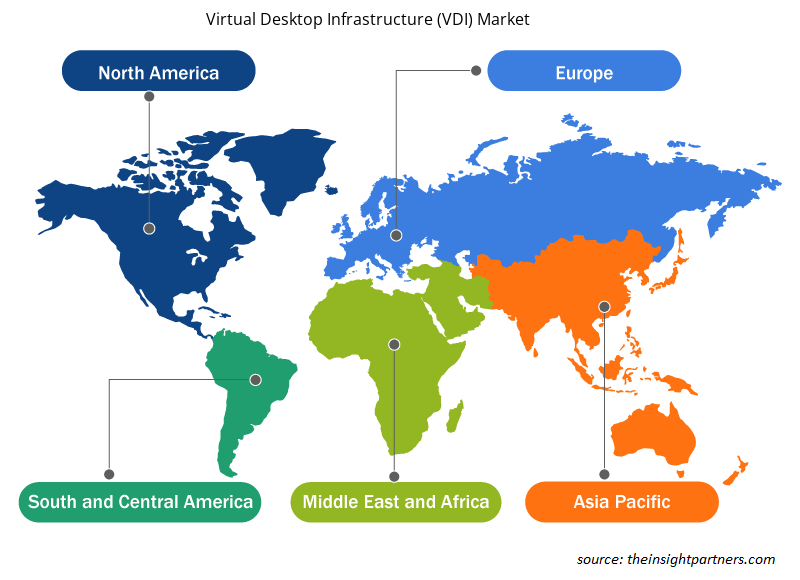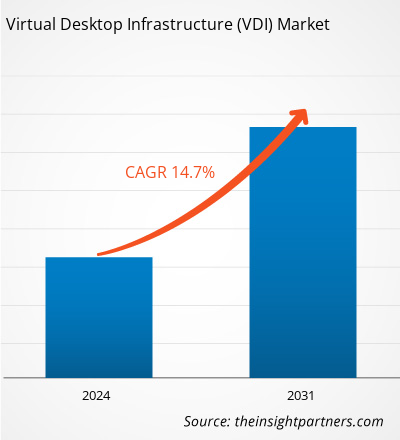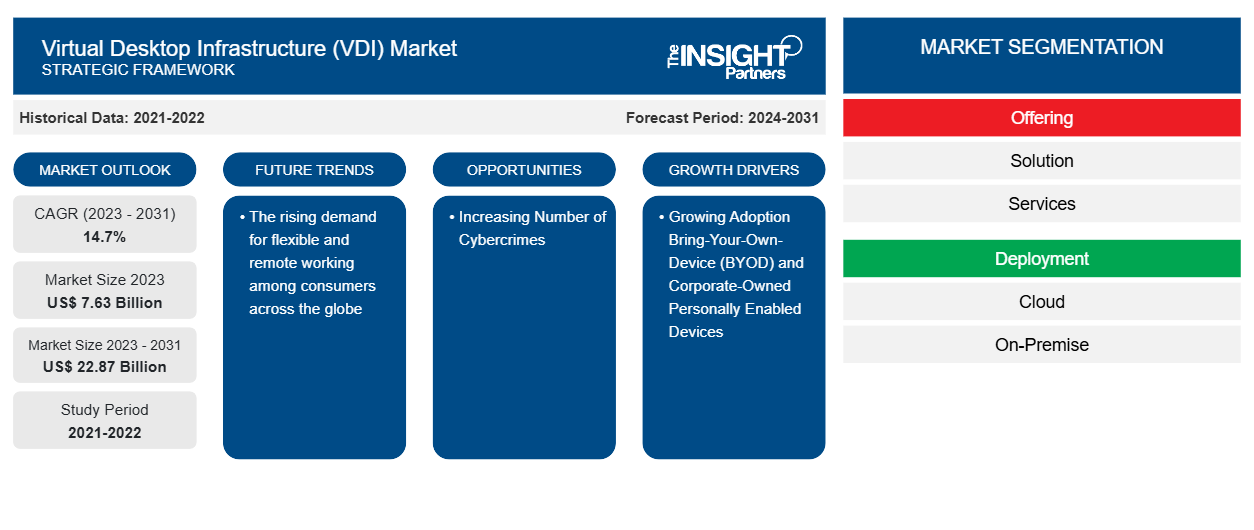虚拟桌面基础设施 (VDI) 市场规模预计将从 2023 年的 76.3 亿美元增至 2031 年的 228.7 亿美元。预计 2023-2031 年市场复合年增长率将达到 14.7%。全球消费者对灵活和远程工作的需求不断增长,这可能仍是虚拟桌面基础设施 (VDI) 市场的一个关键趋势。
虚拟桌面基础设施 (VDI) 市场分析
由于 BYOD 和企业自带个人设备的普及率不断提高,以及消费者对安全的担忧日益增加,虚拟桌面基础架构 (VDI) 市场正在快速增长。受中小企业扩张和政府对安全措施的严格监管推动,市场正在稳步扩张。此外,网络犯罪数量的增加以及人工智能、云计算和物联网等先进技术在虚拟桌面基础架构中的集成,为市场增长提供了有利可图的机会。
虚拟桌面基础设施 (VDI) 市场概览
虚拟桌面基础架构 (VDI) 解决方案通常基于客户端/服务器架构,使用组织的操作系统和应用程序。VDI 解决方案在云或数据中心的服务器上运行。在这种架构中,与用户的所有交互都发生在用户选择的本地设备上。由于现代虚拟桌面工作负载依赖于虚拟桌面基础架构技术,因此 VDI 也是数字工作场所的重要组成部分,该技术在本地或公共云数据中心的虚拟机上运行。这增加了企业对虚拟桌面基础架构的使用,以简化员工的工作,从而推动了市场的发展。
定制此报告以满足您的需求
您可以免费定制任何报告,包括本报告的部分内容、国家级分析、Excel 数据包,以及为初创企业和大学提供优惠和折扣
-
获取此报告的关键市场趋势。这个免费样品将包括数据分析,从市场趋势到估计和预测。
虚拟桌面基础设施 (VDI) 市场驱动因素和机遇
自带设备 (BYOD) 和企业拥有的个人设备日益普及,推动着市场发展
移动劳动力的扩张增加了对虚拟桌面基础设施的需求,以提高企业的生产效率。虚拟桌面基础设施使员工能够使用智能手机、笔记本电脑和手机访问虚拟桌面映像。BYOD 和企业拥有的个人设备日益普及,推动了 IT 和电信行业对虚拟桌面基础设施市场的需求。由于 IT 消费化、移动性和 BYOD,企业面临着采用先进虚拟技术的压力。这增加了他们对开发先进虚拟桌面基础设施以管理 IT 消费化和成本的关注。然而,由于安全性、合规性和治理的增强,桌面虚拟化正变得越来越流行,预计这将在预测期内推动市场发展。
网络犯罪日益增多——虚拟桌面基础设施 (VDI) 市场中的机遇
虚拟化技术的进步促使企业使用虚拟桌面基础架构,以优先考虑安全性和合规性,防止数据泄露和网络攻击。全球网络犯罪数量的增加为市场创造了机会。例如,根据 BioCatch 2023 年 12 月的《北美数字银行欺诈趋势》报告,移动银行的比例在 2023 年增长到 73%。这反过来又导致通过移动设备执行的欺诈行为大幅增加,从 2022 年的 47% 上升到 2023 年的 61%。这增加了用户对虚拟桌面基础架构的采用,以降低风险并保护他们的数据和信息免受网络攻击。
虚拟桌面基础设施 (VDI) 市场报告细分分析
有助于得出虚拟桌面基础设施 (VDI) 市场分析的关键部分是产品、部署、企业规模和最终用户。
- 根据产品,虚拟桌面基础架构 (VDI) 市场分为解决方案和服务。解决方案部分在 2023 年占据了更大的市场份额。
- 就部署而言,市场分为云和本地部署。2023 年,云部分占据了更大的市场份额。
- 根据企业规模,虚拟桌面基础设施 (VDI) 市场分为中小型企业和大型企业。2023 年,中小型企业占据了更大的市场份额。
- 就最终用户而言,虚拟桌面基础架构 (VDI) 市场细分为 IT 和电信、政府、医疗保健、BFSI、教育、零售、制造业和其他最终用户。IT 和电信部门在 2023 年占据了更大的市场份额。
虚拟桌面基础设施 (VDI) 市场份额(按地区)分析
虚拟桌面基础设施(VDI)市场报告的地理范围主要分为五个地区:北美、亚太地区、欧洲、中东和非洲、南美/南美和中美。
就收入而言,由于企业越来越多地采用云技术,北美占据了虚拟桌面基础设施 (VDI) 最大的市场份额。IT 和电信、游戏、消费电子和娱乐行业对虚拟桌面基础设施的需求不断增长,以通过提高运营效率来改善协同工作,这推动了市场的发展。此外,员工对灵活和远程工作的偏好将在不久的将来推动虚拟桌面基础设施 (VDI) 市场的发展。
虚拟桌面基础设施 (VDI) 市场区域洞察
Insight Partners 的分析师已详细解释了预测期内影响虚拟桌面基础架构 (VDI) 市场的区域趋势和因素。本节还讨论了北美、欧洲、亚太地区、中东和非洲以及南美和中美洲的虚拟桌面基础架构 (VDI) 市场细分和地理位置。

- 获取虚拟桌面基础设施 (VDI) 市场的区域特定数据
虚拟桌面基础设施 (VDI) 市场报告范围
| 报告属性 | 细节 |
|---|---|
| 2023 年的市场规模 | 76.3亿美元 |
| 2031 年市场规模 | 228.7亿美元 |
| 全球复合年增长率(2023 - 2031) | 14.7% |
| 史料 | 2021-2022 |
| 预测期 | 2024-2031 |
| 涵盖的领域 |
通过奉献
|
| 覆盖地区和国家 |
北美
|
| 市场领导者和主要公司简介 |
|
虚拟桌面基础设施 (VDI) 市场参与者密度:了解其对业务动态的影响
虚拟桌面基础架构 (VDI) 市场正在快速增长,这得益于最终用户需求的不断增长,而这些需求又源于消费者偏好的不断变化、技术进步以及对产品优势的认识不断提高等因素。随着需求的增加,企业正在扩大其产品范围,进行创新以满足消费者需求,并利用新兴趋势,从而进一步推动市场增长。
市场参与者密度是指在特定市场或行业内运营的企业或公司的分布情况。它表明在给定市场空间中,相对于其规模或总市场价值,有多少竞争对手(市场参与者)存在。
在虚拟桌面基础设施 (VDI) 市场运营的主要公司有:
- 亚马逊公司
- 思科系统公司
- IBM 公司
- 微软公司
- VMware 公司
- 富士通有限公司
免责声明:上面列出的公司没有按照任何特定顺序排列。

- 获取虚拟桌面基础架构 (VDI) 市场顶级关键参与者概述
虚拟桌面基础设施 (VDI) 市场新闻和最新发展
虚拟桌面基础架构 (VDI) 市场通过收集一手和二手研究后的定性和定量数据进行评估,其中包括重要的公司出版物、协会数据和数据库。以下是虚拟桌面基础架构 (VDI) 市场的发展和策略列表:
- 2023 年 8 月,VMware, Inc. VMware 宣布将现代 AI 集成到 Anywhere Workspace 平台,可自动优化员工体验、推动新的漏洞管理用例并简化应用程序生命周期管理。VMware Anywhere Workspace 是唯一集成数字员工体验 (DEX)、虚拟桌面基础架构和应用程序 (VDI 和 DaaS)、统一端点管理 (UEM) 和安全性的混合工作平台,可在任何设备或位置实现无缝且安全的工作空间。(来源:VMware, Inc.,新闻稿,2023 年)
- 2022 年 9 月,亚马逊公司宣布推出 Amazon WorkSpaces Core,这是一项全新的、完全托管的虚拟桌面基础设施 (VDI) 服务,它将 AWS 的安全性、全球可靠性和成本效率与现有的 VDI 管理解决方案相结合。(来源:亚马逊公司,新闻稿,2023 年)
虚拟桌面基础设施 (VDI) 市场报告覆盖范围和交付成果
“虚拟桌面基础设施 (VDI) 市场规模和预测(2021-2031 年)”报告对市场进行了详细分析,涵盖以下领域:
- 范围内所有主要细分市场的全球、区域和国家层面的市场规模和预测
- 市场动态,如驱动因素、限制因素和关键机遇
- 未来的主要趋势
- 详细的 PEST/波特五力分析和 SWOT 分析
- 全球和区域市场分析涵盖关键市场趋势、主要参与者、法规和最新市场发展
- 行业格局和竞争分析,涵盖市场集中度、热点图分析、知名参与者和最新发展
- 详细的公司简介
- 历史分析(2 年)、基准年、预测(7 年)及复合年增长率
- PEST和SWOT分析
- 市场规模、价值/数量 - 全球、区域、国家
- 行业和竞争格局
- Excel 数据集
近期报告
客户评价
购买理由
- 明智的决策
- 了解市场动态
- 竞争分析
- 客户洞察
- 市场预测
- 风险规避
- 战略规划
- 投资论证
- 识别新兴市场
- 优化营销策略
- 提升运营效率
- 顺应监管趋势























 获取免费样品 - 虚拟桌面基础设施(VDI)市场
获取免费样品 - 虚拟桌面基础设施(VDI)市场